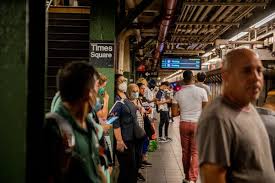Despite the omicron wave, which has hit NYC hard, the fact that the vast majority of city residents are vaccinated - and that it remains the nations center of culture, media and urban excitement, means people just cant stay away for long.
And as for Miami, half the New Yorkers who moved to Florida during the pandemic have already returned to The City. JL
Caroline Spivack reports in New York Magazine:
The Manhattan neighborhoods most people left make up the wealthiest 10% of the city. The majority of those leaving the city didn’t actually leave the region: 79% stayed within the New York metro area. The most popular destination was Brooklyn. Others gave in to the suburbs. The bulk of those who left the tristate area landed in Los Angeles or in Miami. (But) Between July and September 2021, 14 city neighborhoods had more people moving in than during the same time in 2019. And where to? The same neighborhoods that had drained at the height of the pandemic.In the spring of 2020, the dominant narrative in New York was that everyone who could was deserting the city. It quickly became clear that it was mostly the rich who were leaving, rather than a city-killing mass exodus. But this wasn’t the only story; parts of the city actually saw more people moving in during 2020 than in 2019, even as, overall, three times as many New Yorkers fled the city than usual. These are among the findings in a new report from Comptroller Scott Stringer that offers a more comprehensive picture of who left, where they went, and who has come back to New York City over the past 20 months. Here are four takeaways from the report.
Wealthy Neighborhoods Saw the Most People Leave
Every borough experienced a spike in people moving out last year, but Manhattan saw the largest by far. In March, as COVID-19 gripped New York and a slew of pandemic restrictions shuttered the city, Manhattanites fled in droves. In that month alone, 21,547 households in the borough filed change-of-address forms with the U.S. Post Office. The month before, just about 2,000 Manhattanites had left the city. The escape from Manhattan continued for much of the summer at five times the rate as in previous years and in much higher numbers than in any of the other boroughs.
The Manhattan neighborhoods most people left make up the wealthiest 10 percent of the city. But the Upper West Side, which has a median household income nearly double the city average of $70,000, saw more people flee than any other part of New York, with more than 25,000 people leaving the area in 2020 than in 2019.
Most People Who Did Flee Didn’t Go Very Far
The majority of those leaving the city didn’t actually leave the region: Roughly 79 percent of people who made permanent moves stayed within the New York metro area. The most popular destination was Brooklyn, with 20,000 Manhattan residents following in the more than 150-year-old tradition of moving across the East River to find more space. Others gave in to the fact that they would be leaving for the suburbs eventually and just cut to the chase, resulting in a concentrated migration to Westchester County, Suffolk County on Long Island, and western Connecticut. The bulk of those who left the tristate area altogether landed in Los Angeles or in Miami’s up-and-coming Little Manhattan. All told, some 19,000 New Yorkers ended up in Florida, but 9,000 of those moves were temporary.
The Neighborhoods That Almost No One Left
While Manhattan lost (at least temporarily) a small city’s worth of people, many parts of the city remained more or less the same. Jackson Heights in Queens, Melrose in the Bronx, and East New York in Brooklyn together had 1,100 people move away in 2020 — that’s just 400 more than left all three neighborhoods in 2019. The same was true for some 70 Zip Codes across the city, many of them in the Bronx, Queens, and parts of Brooklyn. The neighborhoods that stayed relatively static throughout the pandemic tended to be lower-income areas where essential workers live and had to work in person. Residents of these areas also don’t necessarily have the means to leave the city.
Who Ultimately Came Back?
In early summer — around the same time as office workers began to return to their actual desks and Washington Square Park turned into a full-on rave — there was a jump in moving-truck traffic on residential Manhattan streets. Between July and September 2021, 14 city neighborhoods had more people moving in than during the same time in 2019. And where to? The same neighborhoods that had drained at the height of the pandemic, including Chelsea, Murray Hill, and Greenwich Village. Now, not only have rents in Manhattan shot back up, there’s actually more competition, too, because more new people have moved to the city in 2021 than in 2019. The city’s 6,332 new New Yorkers are putting the squeeze on the rental market, but they’re also proof that this city that was said to be on the brink of death is as alive as ever — if not more so.




















0 comments:
Post a Comment